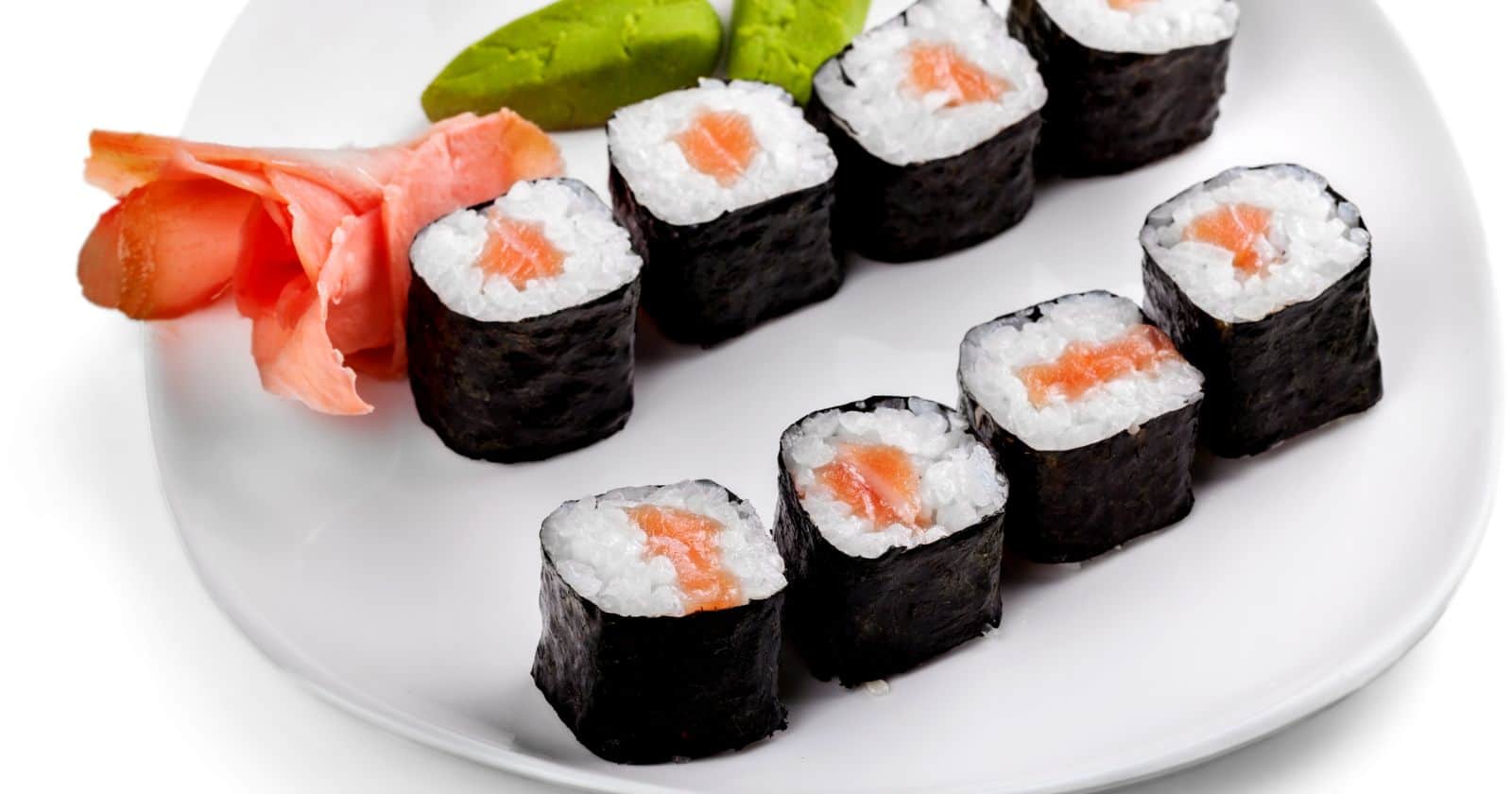Hey sushi lovers! Ever wonder how pro chefs choose the right nori size for rolls? With so many options from full sheets to strips, it can get confusing. No worries – this article will clear it all up!
Nori sheets come in tons of sizes. Chefs pick based on the sushi style:
- Full sheets are used for big rolls like futomaki or uramaki.
- Half sheets work well for skinny hosomaki with just one filling.
- Quarter sheets are ideal for petite rolls and hand rolls.
- Eighth sheets let you add just a touch of nori flavor.
The key is using nori that fits your roll, not too much or too little. And don’t forget to place the shiny side down when rolling!
Now that you know how to pick the perfect nori, let’s roll into the details…
Full Sheets – For Big Rolls
The first main size is a full 8 x 7 inch nori sheet. This is best for:
- Futomaki – Thick rolls packed with fillings
- Uramaki – Inside-out rolls with rice on the outside
Full sheets give you ample space to pile on fish, veggies, or whatever your heart desires. Feel free to stuff these rolls with abandon!
With the large surface area, there’s room to cut thick futomaki and uramaki into bite-sized pinwheels.
For these chunky specialty rolls, always reach for a full sheet.
Halves – For Skinny Hosomaki
Another option is using half sheets around 3.5 x 7 inches. These work well when making:
- Hosomaki – Thin rolls with just one filling
Half sheets are perfect for skinny rolls where less nori is needed. A little goes a long way with simple hosomaki.
Some classic one-filling rolls are:
- Kappamaki – Cucumber
- Kanpyomaki – Sweet pickled gourd
- Negitoromaki – Scallions
For these pared down rolls, half a sheet is all you need.
Quarters – For Mini Rolls
Quarter sheets around 4 x 3.5 inches are great for:
- Petite rolls
- Temaki hand rolls
When you want to go mini, reach for quartered nori.
Smaller rolls are quicker to make and perfect for parties. Pass around trays of bite-sized sushi in no time.
Quarter sheets also work well for temaki. These hand rolled cones are fun to make and eat.
If tiny sushi is on your agenda, break out the quarter sheets.
Eighths – For Garnishing
The last size is eighths around 2 x 3.5 inches. What are these petite strips good for?
- Garnishing sushi
- Adding subtle nori flavor
Eighth sheets allow you to add a touch of nori without overdoing it. They are excellent garnishes for poke bowls, seaweed salads, and chilled soups.
Use them to make nori strips for sprinkling over rice dishes too.
When you want just a hint of ocean flavor, reach for eighth size sheets.
Picking the Right Size
Now you know all the common nori dimensions available. Here are some tips for picking the right size:
Match the nori to the roll thickness. Thin fillings only need half or quarter sheets. Bulky rolls require bigger full sheets.
Consider how many pieces you want. Quarter sheets yield more rolls from one nori. Full sheets allow bigger slices.
If garnishing, go small. Eighths or striped quarters give plenty of flavor without overwhelm.
Use what you have on hand. Improvise with available sizes – don’t let it limit your creativity!
Placing Nori Properly for Rolls
You’ve got your perfectly sized nori – now it’s time to use it! Proper placement is key for rolls that hold together.
Follow these tips when placing nori:
Align Nori Lengthwise
Position nori sheets lengthwise in front of you. The longer side should be parallel to your work surface.
This creates a wider “road” to roll upon. Rolling across the short side is tricky.
Place Shiny Side Down
Nori has a shiny, smooth side and a rough, matte side.
The shiny side should face downwards when assembling rolls. This side sticks to the rice better.
Placing it rough side down can cause rolling troubles. So shiny goes below!
Leave 1/4 Uncovered
Don’t cover the entire nori sheet with rice. Leave the furthest quarter uncovered.
This gives you an “edge” to start your roll. Rolling uncovered nori is impossible.
The sticky rice-free strip lets you seal up rolls neatly.
Spread Rice Evenly
Use your fingers to spread rice in an even layer over the bottom 3/4 of nori.
Don’t leave thick or thin spots. Consistent rice makes for better rolling.
Add Fillings in a Line
Place fillings like fish, veggies, or avocado in a line down the center of rice.
This filling distribution prevents lumpy rolls. Leaving gaps can throw off the balance.
Now you’re ready to roll like a sushi chef!
Rolling Techniques for Beginners
You’ve got perfectly sized nori placed properly. Time to transform it into sushi with some key rolling techniques:
Step 1 – Roll the First Lap
After adding fillings, begin rolling the uncovered nori edge over your ingredients.
Use your fingers to gently roll the first lap upward. Go slow and keep ingredients tucked in.
Step 2 – Compress as You Roll
Continue rolling upward, using your fingers to compress the roll gently inward.
Even pressure pushes out air pockets. This helps the roll hold its shape.
Step 3 – Brush With Water
When 3/4 rolled, use a fingertip to brush water along the top of the uncovered nori.
This water activates the nori’s stickiness. It will seal the final lap shut.
Step 4 – Finish the Roll
Finish rolling up to seal the moistened nori edge. Apply light pressure all around the rolled log.
Set seam side down and let rest 2 minutes. This helps the roll seal and hold form.
Correct Common Mistakes
- Uncovered nori won’t seal? Brush with more water before final roll.
- Filling falling out? Compress roll tighter as you go.
- Rice sticking to hands? Wet fingers slightly before handling rice.
Keep practicing and your rolling skills will improve each time!
Cutting Rolls for Beautiful Pieces
You did it – you rolled stunning sushi worthy of a 5-star restaurant! Now it’s time to slice it up.
Follow these tips for picture-perfect roll cutting:
Use a Sharp Knife
A dull knife will smash and mangle rolls. Use a sharp chef’s knife for clean cuts.
Prioritize this – all other techniques depend on a quality blade!
Cut Rolls While Fresh
Don’t let rolls sit before cutting. Slice immediately for prettiest pieces.
The rice starts to glue together quickly, making cuts messy.
Wet Knife Between Slices
Dip knife in water before each slice. This prevents rice from sticking to the blade.
Try placing a damp cloth under the board too.
Slice Decisively
Cut down in decisive strokes without sawing back and forth. Quick, smooth cuts look best.
Hesitating mashes the rice unevenly.
Start in the Middle
Make the first slice through the center of the roll. Then cut equal pieces moving outward from the middle.
This helps if fillings are unevenly distributed inside.
Fix Smushed Ends
If end pieces get smushed, simply reshape and press back into form.
With practice your rolls will be sliced like a pro sushi chef’s!
Packing Sushi Rolls for Travel
Want to bring your homemade sushi creations on picnics or to parties? Here are some tips for travel-ready rolls:
Pack Tightly
Fill containers to capacity with rolls. Stack them snugly with minimal gaps.
This prevents shaking and movement during transport.
Use Dividers
Cut strips of parchment or wax paper to separate layers and rows.
Dividers protect sushi from direct contact and friction.
Travel in Bento Boxes
Sectioned Japanese bento boxes are ideal for organizing sushi.
Custom compartments prevent messing or damage.
Transport Smaller Rolls
Mini rolls hold up better than large futomaki or uramaki.
Opt for hosomaki, thin uramaki, or temaki cones.
Bring Self-Contained Fillings
Instead of loose ingredients, use fillings that travel well like:
- Tofu
- Avocado
- Cucumber
These stay neatly inside the roll.
Use Sturdy Paper
Skip plastic wrap and pack rolls in parchment or wax paper. These more rigid papers prevent crushing.
With the right containers and papers, your rolls can be enjoyed anywhere!
Nori Alternatives for Sushi
Want to skip the nori but keep the sushi? Try these seaweed free alternatives:
Soy Paper
These edible translucent sheets soften when wet. Use for wrapping rice and fillings burrito-style.
Cucumber
Wide strips of cucumber can sub for nori. Their stiffness helps rolls hold shape.
Omelette
Make thin egg crepes to wrap rice and fillings. Fry plain or season the eggs.
Lettuce Leaves
Sturdy lettuces like romaine work great. Wrap up rice and fillings in ruffled green leaves.
Zucchini
Slice zucchini lengthwise into long thin strips with a peeler. Use “zoodles” in place of nori.
Carrots
Similarly, peel carrots into wide ribbons. These orange strips add a sweet crunch.
With so many nori-free options, those with seaweed allergies can still enjoy homemade sushi!
FAQs About Nori Sizes
Here are answers to common questions on sushi nori dimensions:
What’s the standard size of a full nori sheet?
The typical full size is 8 x 7 inches (20×18 cm). This yields around 6 rolls.
Are sushi nori sheets the same as the snack sheets?
Not always. Snack sheets meant for eating are often wider than those for rolling sushi in restaurants. Check dimensions.
Where can I buy different nori sizes?
Asian grocery stores offer the widest size selection. Regular grocers may only have full sheets. Order specialty sizes online.
How can I cut standard sheets into smaller sizes?
Use a sharp knife or kitchen shears on a cutting board. Cut evenly in half horizontally for two quarters. Stack and cut crosswise into eighths.
Should I use full sheets if I’m a sushi beginner?
It’s fine to start with any size – just match it to the roll you want to make. There’s no need to start big! Begin with quarters or eighths if preferred.
Does nori need to cover the whole roll?
No, leave 1/4 uncovered. But for hand rolls, nori can wrap all the way around like a cone. Play with complete and partial coverage!
I hope this article has boosted your sushi skills and confidence picking nori sizes! Remember, let your creative roll ideas dictate the best sheet size. With the right nori dimensions, you’ll be churning out picture-perfect sushi creations in no time.





